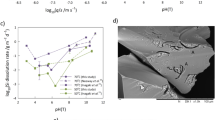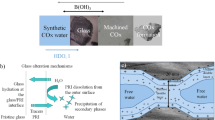Abstract
The long-term behaviour of vitrified high-level waste in an underground clay repository was assessed by using the reactive transport model HYTEC with respect to silica diffusion, sorption and precipitation processes. Special attention was given to the chemical interactions between glass, corroded steel and the host-rock considering realistic time scale and repository design. A kinetic and congruent dissolution law of R7T7 nuclear glass was used assuming a first-order dissolution rate, which is chemistry dependent, as well as a long-term residual rate. Without silica sorption and precipitation, glass dissolution is diffusion-driven and the fraction of altered glass after 100,000 years ranges from 5to 50depending on the fracturation degree of the glass block. Corrosion products may limit glass dissolution by controlling silica diffusion, whereas silica sorption on such products has almost no effect on glass durability. Within the clayey host-rock, precipitation of silicate minerals such as chalcedony may affect glass durability much more significantly than sorption. In that case, however, a concomitant porosity drop is predicted that could progressively reduce silica diffusion and subsequent glass alteration.
Similar content being viewed by others
References
E. Vernaz, S. Gin, C. Jégou and I. Ribet, J. Nucl. Mater. 298, 27 (2001).
P. van Iseghem, E. Valcke and A. Lodding, J. Nucl. Mater. 298, 86 (2001).
P. Jollivet, Y. Minet, M. Nicolas and E. Vernaz, J. Nucl. Mater. 281, 231 (2000).
S. Gin, P. Jollivet, J.P. Mestre, M. Jullien and C. Pozo, Appl. Geoch. 16, 861 (2001).
M. Aertsens and P. van Iseghem, ENS Meeting Proc. (Antwerpen, Belgium), 339 (1999).
S. Maillard and D. Iracane, Mat. Res. Soc. Symp. Proc. 506, 231 (1998).
J. van der Lee, L. De Windt, V. Lagneau and P. Goblet, Comp. Geosc. 29, 265 (2003).
N. Marmier and F. Fromage, J. Coll. Interf. Sc. 223, 83 (2000).
V. Philippini, S. Leclercq and H. Catalette, Techn. Rep. EdF HT-29/04/026/A (2004).
E. Curti, Techn. Rep. PSI 03-18 (2003).
L. De Windt, J. Cabrera and J.-Y. Boisson, Geol. Soc. London Spec. Publ. 157, 167 (1999).
M.H. Bradbury and B. Baeyens, J. Cont. Hydr. 27, 223 (1997).
B. Grambow and R. Müller, J. Nucl. Mater. 298, 112 (2001).
S. Gin and P. Frugier, Mat. Res. Soc. Symp. Proc. 757, 175 (2003).
Author information
Authors and Affiliations
Rights and permissions
About this article
Cite this article
Windt, L.D., Leclercq, S. & van der Lee, J. Assessing the durability of nuclear glass with respect to silica controlling processes in a clayey underground disposal. MRS Online Proceedings Library 932, 931 (2006). https://doi.org/10.1557/PROC-932-93.1
Published:
DOI: https://doi.org/10.1557/PROC-932-93.1




